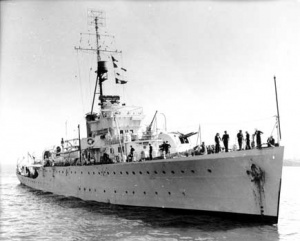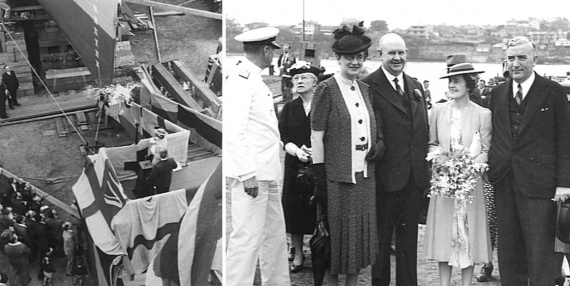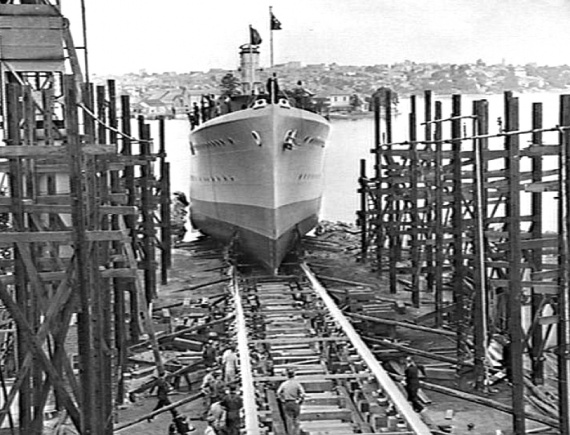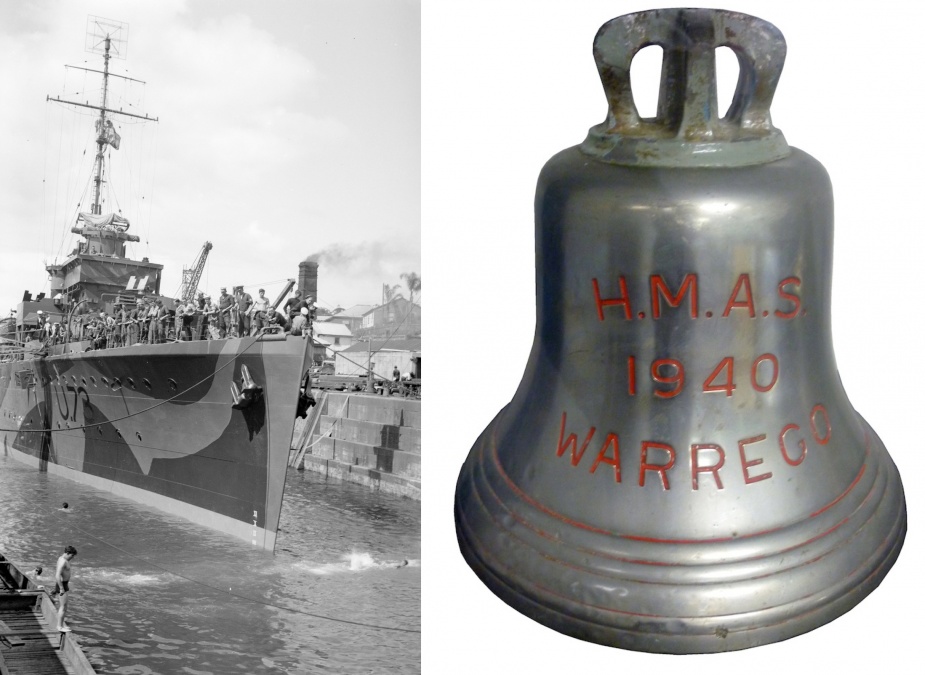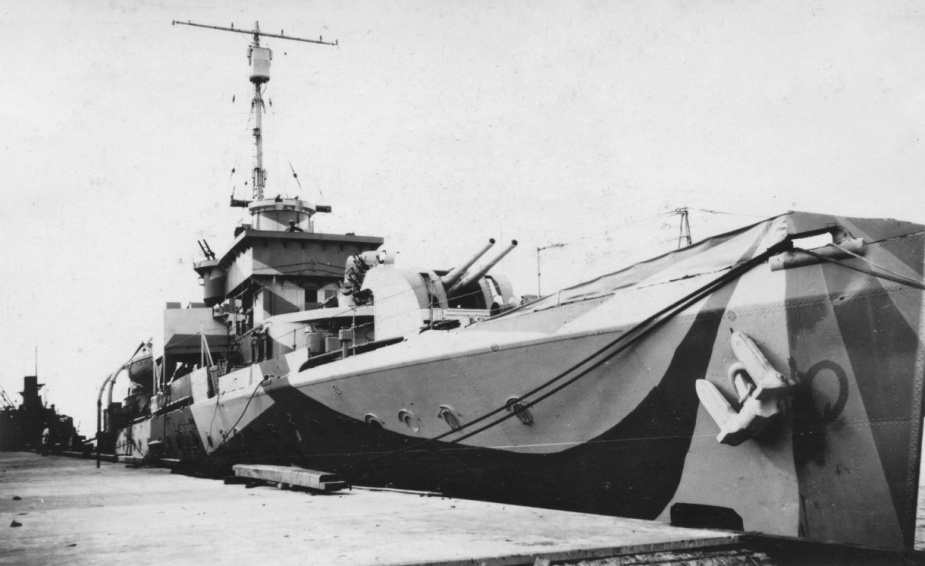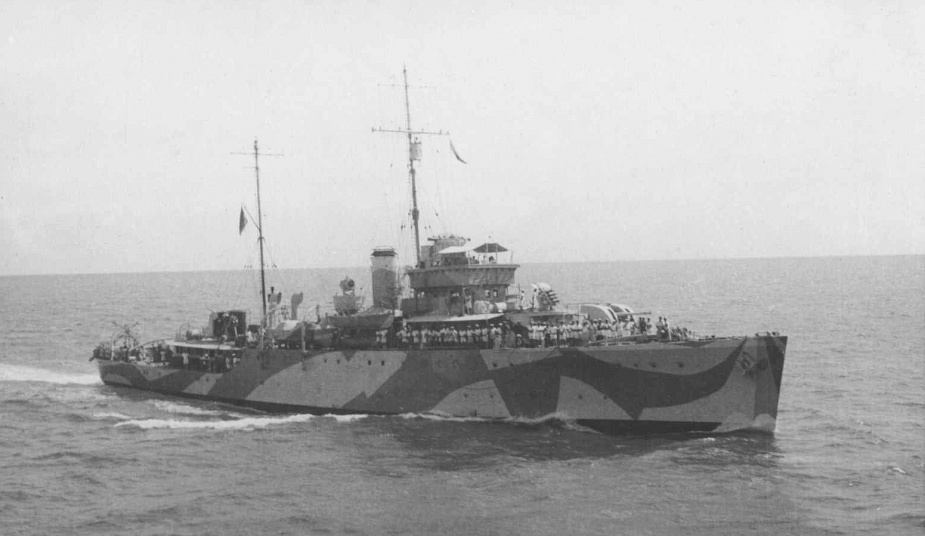HMAS Warrego (II)
| Class |
Grimsby Class |
|---|---|
| Type |
Sloop |
| Pennant |
U73 |
| Builder |
Cockatoo Docks and Engineering Co Ltd, Sydney |
| Laid Down |
15 May 1939 |
| Launched |
10 February 1940 |
| Launched by |
Mrs Pattie Menzies, wife of the Prime Minister |
| Commissioned |
22 August 1940 |
| Decommissioned |
15 August 1963 |
| Dimensions & Displacement | |
| Displacement |
|
| Length | 266 feet 3 inches |
| Beam | 36 feet |
| Draught | 15 feet |
| Performance | |
| Speed | 17 knots |
| Propulsion | |
| Machinery | Parsons geared turbines, twin screws |
| Armament | |
| Guns | 4 x 4-inch guns |
| Other Armament |
|
| Awards | |
| Inherited Battle Honours | |
| Battle Honours | |
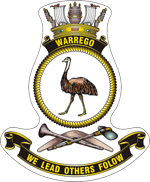
HMAS Warrego (II) was laid down on 15 May 1939 at Cockatoo Island Dockyard, Sydney. She was launched by Mrs Pattie Menzies, wife of the then Prime Minister Robert Menzies, on 10 February 1940 before commissioning in the RAN on 22 August 1940 under the command of Commander RV Wheatley RAN.
Following a series of acceptance trials and exercises in the Sydney area, Warrego (II) proceeded via Melbourne to Fremantle where she was briefly employed on local escort duty. On 29 September 1940 she returned to Melbourne, where, the Prime Minister inspected the ship on 6 October
At Melbourne on 10 October 1940, Warrego (II) assumed duty as Senior Officer, 20th Minesweeping Flotilla then comprising HMA Ships Warrego (II) (Leader), Swan (II), Orara (I), Durraween (I) and Doomba (I). Warrego (II) operated as a minesweeper until 3 December 1941. During this period she was engaged in the sweeping operations to clear the minefields laid by the German ships Pinguin and Passat in Victorian, Tasmanian, South Australian and New South Wales waters in October and November 1940.
In late December 1941 Warrego (II) proceeded to Port Moresby and thence to Darwin where she arrived on 9 January 1942. Operating from Darwin she was employed mainly on local anti-submarine and escort duties. She was also one of the escorts for four troop transports bound for Koepang, Timor, which left Darwin on 15 February 1942. The convoy was attacked by a Japanese flying boat that day giving Warrego (II) her first chance to open fire against the enemy. The following day, 16 February, the convoy was attacked by a flight of 45 enemy aircraft and was forced to return to Darwin but suffered only minor damage.
Warrego (II) was at Darwin on 19 February 1942 when Admiral Nagumo's carrier borne aircraft delivered the first enemy attack on the Australian mainland and in spite of the intensity of the attack she was fortunate to escape damage. On 25 February 1942 she left the Darwin area, proceeding into the Indian Ocean and thence to Fremantle and Sydney. Excepting for a voyage to Brisbane the sloop was at Sydney refitting until the end of May 1942.
On 31 May Warrego (II) sailed from Sydney escorting a New Guinea bound convoy. Thereafter until the end of the year she was employed escorting convoys between Townsville, Port Moresby and Milne Bay interspersed by periods of duty on anti submarine patrol at Milne Bay . In October 1942 the routine of escort and patrol duty was broken when she spent four days on a survey of Moresby Strait and the approaches to Mud Bay, Goodenough Island. Until the sloop arrived at Cairns on 22 December, where she remained boiler cleaning until 2 January 1943, she was almost constantly at sea. Between 15 November and 22 December she was under way on 33 out of 37 days. On 31 December 1942 Warrego (II) had steamed 78,870 miles since commissioning.
In January 1943 Warrego (II) resumed duty escorting the continuous flow of shipping to New Guinea. A brief change in her routine was occasioned by voyages escorting Thursday Island-Darwin convoys. She also escorted ships to Onslow on the West Australian coast. On 21 February 1943 when escorting SS Maetsuycker from Onslow to Darwin the sloop was attacked by a single Japanese aircraft. Three bombs were dropped which were "distinctly heard passing over the ship" before falling into the sea 100 yards astern.
Warrego (II) sailed from Darwin on 23 February 1943 and on arrival at Thursday Island resumed her former role as an escort vessel to New Guinea , operating between Townsville, Milne Bay and Merauke. In June 1943 she began a long refit at Brisbane which kept her in dockyard hands until 20 September.
In October 1943 mainland to New Guinea convoy duty was resumed and excepting for a visit to Darwin in February 1944 Warrego (II) was employed until May 1944 when she transferred to the New Guinea area to act as an escort vessel in the forward areas. In July 1944 she was transferred to the US Seventh Fleet Survey Group (TG 70.5) for survey duties in New Guinea waters.
On 15 October 1944 Warrego (II) arrived in Sydney to refit. The work was completed early in December, and on 7 December she departed Sydney to return to New Guinea. On 28 December she departed Hollandia as a unit of the United States forces assembled for the landing at Lingayen Gulf in the Philippines. She acted as screening unit during the landing operations before taking up survey duty with TG 70.5.
The sloop was engaged on various survey operations in the Philippines until the end of May 1945 when she left Leyte to return to New Guinea. In mid-June she took part in the bombardment of Wewak, New Guinea, in support of the Australian forces ashore.
In July 1945 she was a unit of the Task Force supporting the landing of the Australian troops at Balikpapan, Borneo, and when this operation was successfully completed she again returned to Sydney for refitting. The refit was in progress when hostilities ceased at which time Warrego (II) had steamed some 170,000 miles on war service. The immediate post war period saw Warrego (II) operating in the Morotai and Borneo areas, before returning to Sydney in December 1945.
During 1946 Warrego (II) conducted surveys off Tasmania, in Bass Strait and off Gladstone. By year's end she had been placed in dockyard hands for refit, then reduced to a Special Reserve complement in early 1947. Remobilised in January 1948, Warrego (II) recommenced survey operations in Tasmania. This was followed by further surveys in Queensland waters in the latter half of the year and in Bass Strait in early 1949.
On completion of the Bass Strait survey, Warrego (II) returned to Sydney in May 1949 where she was immobilised and remained in such a state alongside Garden Island until she recommissioned on 14 June 1951. One notable incident that occurred during this period was the explosion in the Landing Ship Tank (LST) HMAS Tarakan (I) on 25 January 1950 - seven sailors and one dockyard tradesman were killed and a number of others injured. Warrego (II) supplied fire fighting equipment and stretchers.
Returning to sea in June 1951 for post recommissioning trials, Warrego (II) deployed to the Monte Bello Islands off Western Australian for preparatory surveys prior to the British atomic test that would take place the following year. Having completed the survey in August, Warrego (II) visited Timor, Port Moresby, Manus Island and the Solomon Islands, her first overseas port visits in six years.
In 1952 Warrego (II) commenced the first of what would prove to be many survey seasons in the waters off South Australia. She also conducted survey operations within Exmouth Gulf between August and November 1952, and was in Exmouth Gulf when the first British atomic test, Operation HURRICANE, took place at Monte Bello on 3 October 1952.
During the mid-1950s Warrego (II) continued the routine but valuable and essential survey work. In 1953 she surveyed Bass Strait and the waters off Cape Otway and Gladstone. Warrego (II) returned to the Cape Otway in both 1954 and 1955.
In October and November 1955 Warrego (II) visited the Monte Bello Islands to assist HMAS Karangi (I) repair beacons and other work in preparation for the 1956 series of atomic tests.
Much of 1956 was spent in Queensland waters with Warrego (II) splitting her time in 1957 between Queensland and South Australia. In 1958 Warrego (II) was tasked to commence operations in the Sahul Banks area in the Timor Sea, for the purpose of surveying deep draught shipping routes.
Following completion of her annual refit in March 1959, Warrego (II) proceeded to the Whitsunday Islands area for survey operations that occupied the ship until August. During July she rediscovered a pinnacle rock obstruction in Pioneer Bay that had first been reported in 1916. Sadly one of her ship's company drowned in a boating accident off Hook Island during the same month.
In late 1959 Warrego (II) performed a number of trials, in company with HMAS Kimbla (I), on behalf of the RAN Experimental Laboratory. Further trials were conducted in May 1960 between surveys.
In June 1960 Warrego (II) sailed for survey operations in the Bowen area. On 11 June, shortly after the survey had commenced, Warrego (II) was diverted to Mackay after TAA Fokker F27 Friendship VH-TFB, named Abel Tasman, crashed into the sea during the evening of 10 June with the loss of 29 passengers and crew - Australia's worst air disaster.
Warrego (II) remained on task assisting the Department of Civil Aviation until 26 June and, supported by Kimbla (I) and clearance divers from HMAS Rushcutter, salvaged 95 percent of the wreckage of VH-TFB from the seabed.
Between March and June 1961 Warrego (II) was surveying in the vicinity of Kangaroo Island off South Australia. Later in June she participated in the ceremonial fleet entry into Sydney Harbour, a highlight of the Royal Australian Navy's Jubilee celebrations. A short period in refit was followed by surveys in the Great Barrier Reef area.
Warrego (II) returned to South Australia in March 1962 for operations in Spencer Gulf. Later in 1962 Warrego (II) briefly visited Port Moresby prior to operations in the Gulf of Carpentaria.
During her last year of commission, Warrego (II) further surveyed the Spencer Gulf area; between March and June 1963, and again from July to August. Having completed her last survey, Warrego (II) sailed from Port Lincoln on 3 August 1963 for Sydney, where she arrived on 8 August.
Warrego (II) paid off on 15 August 1963, one week short of her 23rd birthday, having steamed 440,978 miles since commissioning on 22 August 1940. In the post war period Warrego (II) made a significant contribution to the survey of Australian waters, steaming some 271,000 miles on post war survey duties alone. She was replaced in the fleet by HMAS Moresby (I), which commissioned in March 1964.
Warrego (II) was declared for disposal in 1964 and on 2 June 1965 was sold to Metal Traders (Australia) Pty Ltd, Sydney. She was broken up at Rozelle Bay, Sydney, in 1966.
Further reading
'HMAS Warrego: A History' by Sidney O Marshall. Paul Marshall, Otford 1977.

